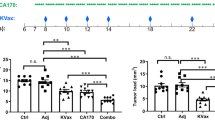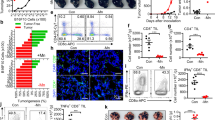Abstract
Trichosanthin (TCS), extracted from the Chinese medicinal herb Trichosanthes kirilowi, has shown promise for the inhibition of tumor growth. However, its immunomodulatory effect on tumor–host interaction remains unknown. In this study, we focused on the effect of TCS on murine anti-tumor immune response in the 3LL Lewis lung carcinoma tumor model and explored the possible molecular pathways involved. In addition to inhibiting cell proliferation and inducing apoptosis in the 3LL tumor, TCS retarded tumor growth and prolonged mouse survival more significantly in C57BL/6 immunocompetent mice than in nude mice. This reflected the fact that the host immune system was involved in tumor eradication. Using FACS analysis, we found that TCS increased the percentage of effector T cells, particularly Interferon-gamma (IFN-γ) producing CD4+ and CD8+ T cells from tumor-bearing mice. TCS also promoted the vigorous proliferation of antigen-specific effector T cells, markedly increased Th1 cytokine secretion and elicited more memory T cells in tumor-bearing mice, consequently enhancing the anti-tumor response and inducing immune protection. Furthermore, we found that TCS upregulated the expression of tumor suppressor in lung cancer 1 (TSLC1) in 3LL tumor cells and the expression of its ligand, class I-restricted T cell-associated molecule (CRTAM), in effector T cells. Blocking TSLC1 expression with small interfering RNA (siRNA) significantly eliminated the effects of TCS on the proliferation and cytokine secretion of effector T cells, suggesting that TCS enhances anti-tumor immune response at least partially by boosting the interaction between TSLC1 and CRTAM. Collectively, our data demonstrate that TCS not only affects tumor cells directly, but also enhances anti-tumor immunity via the interaction between TSLC1 and CRTAM. These findings may lead to the development of a novel approach for tumor regression.
This is a preview of subscription content, access via your institution
Access options
Subscribe to this journal
Receive 12 digital issues and online access to articles
$119.00 per year
only $9.92 per issue
Buy this article
- Purchase on Springer Link
- Instant access to full article PDF
Prices may be subject to local taxes which are calculated during checkout






Similar content being viewed by others
References
Khan N, Afaq F, Mukhtar H . Cancer chemoprevention through dietary antioxidants: progress and promise. Antioxid Redox Signal 2008; 10: 475–510.
Xiong SD, Yu K, Liu XH, Yin LH, Kirschenbaum A, Yao S et al. Ribosome-inactivating proteins isolated from dietary bitter melon induce apoptosis and inhibit histone deacetylase-1 selectively in premalignant and malignant prostate cancer cells. Int J Cancer 2009; 125: 774–782.
Wang YH, Huang LM . The effect of the trichosanthin on the methylation and expression of TSLC1 gene in cervical carcinoma HeLa cells. Lett Biotechnol 2008; 19: 217–220.
Shaw PC, Lee KM, Wong KB . Recent advances in trichosanthin, a ribosome-inactivating protein with multiple pharmacological properties. Toxicon 2005; 45: 683–689.
Collins EJ, Robertus JD, LoPresti M, Stone KL, Williams KR, Wu P et al. Primary amino acid sequence of alpha-trichosanthin and molecular models for abrin A-chain and alpha-trichosanthin. J Biol Chem 1990; 265: 8665–8669.
Chow TP, Feldman RA, Lovett M, Piatak M . Isolation and DNA sequence of a gene encoding alpha-trichosanthin, a type I ribosome-inactivating protein. J Biol Chem 1990; 265: 8670–8674.
Shaw PC, Yung MH, Zhu RH, Ho WK, Ng TB, Yeung HW . Cloning of trichosanthin cDNA and its expression in Escherichia coli. Gene 1991; 97: 267–272.
Ding GS . Important Chinese herbal remedies. Clin Ther 1987; 9: 345–357.
Chan WY, Huang H, Tam SC . Receptor-mediated endocytosis of trichosanthin in choriocarcinoma cells. Toxicology 2003; 186: 191–203.
Wang YY, Ouyang DY, Huang H, Chan H, Tam SC, Zheng YT . Enhanced apoptotic action of trichosanthin in HIV-1 infected cells. Biochem Biophys Res Commun 2005; 331: 1075–1080.
Wang P, Chen LL, Yan H, Li JC . Trichosanthin suppresses HeLa cell proliferation through inhibition of the PKC/MAPK signaling pathway. Cell Biol Toxicol 2009; 25: 479–488.
Huang YL, Huang LM, Shi XL . Effect of trichosanthin on apoptosis induction in cervical carcinoma Hela cells and expression of Bax and Bcl-2. J Parct Train Med 2007; 35: 32–35.
Bronte V, Mocellin S . Suppressive influences in the immune response to cancer. J Immunother 2009; 32: 1–11.
Wang QZ, Xu W, Habib N, Xu R . Potential uses of microRNA in lung cancer diagnosis, prognosis, and therapy. Curr Cancer Drug Targets 2009; 9: 572–594.
Zhao S, Wang Y, Wei H . Trichosanthin induced Th2 polarization status. Cell Mol Immunol 2006; 3: 297–301.
Hua F, Shan BE, Zhao LM, Yao ZG, Peng H . Trichosanthin inhibited the proliferation of MDA-MB-231 cells and reversed the methylation of syk gene. Tumor 2009; 29: 944–949.
Boles KS, Barchet W, Diacovo T, Cella M, Colonna M . The tumor suppressor TSLC1/NECL-2 triggers NK-cell and CD8+ T-cell responses through the cell-surface receptor CRTAM. Blood 2005; 106: 779–786.
Yeh JH, Sidhu SS, Chan AC . Regulation of a late phase of T cell polarity and effector functions by Crtam. Cell 2008; 132: 846–859.
Liu R, Xiong S, Zhang L, Chu Y . Enhancement of antitumor immunity by low-dose total body irradiation is associated with selectively decreasing the proportion and number of T regulatory cells. Cell Mol Immunol 2010; 7: 157–162.
Baratelli F, Lin Y, Zhu L, Yang SC, Heuzé-Vourc'h N, Zeng G . Prostaglandin E2 induces FOXP3 gene expression and T regulatory cell function in human CD4+ T cells. J Immunol 2005; 175: 1483–1490.
Xia XF, Wang F, Sui SF . Effect of phospholipid on trichosanthin adsorption at the air–water interface. Biochim Biophys Acta 2001; 1515: 1–11.
Gu YJ, Xia ZX . Crystal structures of the complexes of trichosanthin with four substrate analogs and catalytic mechanism of RNA N-glycosidase. Proteins 2000; 39: 37–46.
Li M, Li X, Li JC . Possible mechanisms of trichosanthin-induced apoptosis of tumor cells. Anat Rec (Hoboken) 2010; 293: 986–992.
Zhang C, Gong Y, Ma H, An C, Chen D, Chen ZL . Reactive oxygen species involved in trichosanthin-induced apoptosis of human choriocarcinoma cells. Biochem J 2001; 355: 653–661.
Zhang CY, Gong YX, Ma H, An CC, Chen DY . Trichosanthin induced calcium-dependent generation of reactive oxygen species in human choriocarcinoma cells. Analyst 2000; 125: 1539–1542.
Langer M, Mockel B, Eck J, Zinke H, Lentzen H . Sitespecific mutagenesis of mistletoe lectin: the role of RIP activity in apoptosis. Biochem Biophys Res Commun 1999; 264: 944–948.
Li M, Chen F, Liu CP, Li DM, Li X, Wang C et al. Dexamethasone enhances trichosanthin-induced apoptosis in the HepG2 hepatoma cell line. Life Sci 2010; 86: 10–16.
Seliger B . Strategies of tumor immune evasion. Biodrugs 2005; 19: 347–354.
Zhou H, Jiao Z, Pan J, Hong J, Tao J, Li N et al. Immune suppression via IL-4/IL-10-secreting T cells: a nontoxic property of anti-HIV agent trichosanthin. Clin Immunol 2007; 122: 312–322.
Xing XS, Huang LM, Huang YL, Chen MH, Shi XL . Detection of human cervical carcinoma Hela cell by methylation specific polymerase chain reaction. China J Mod Med 2006; 16: 191–194.
Kennedy J . A molecular analysis of NKT cells: indentification of a class-I restricted T cell-associated molecule (CRTAM). J Leukoc Biol 2000; 67: 725–734.
Fukami T, Fukuhara H, Kuramochi M, Maruyama T, Isogai K, Sakamoto M et al. Promoter methylation of the TSLC1 gene in advanced lung tumors and various cancer cell lines. Int J Cancer 2003; 107: 53–59.
Mao X, Seidlitz E, Truant R, Hitt M, Ghosh HP . Re-expression of TSLC1 in a non-small-cell lung cancer cell line induces apoptosis and inhibits tumor growth. Oncogene 2004; 23: 5632–5642.
Takeuchi A, Itoh Y, Takumi A, Ishihara C, Arase N . CRTAM confers late-stage activation of CD8+ T cells to regulate retention within lymph node. J Immunol 2009; 183: 4220–4228.
Takashi M, Koichi Y, Jean-David B, Manabu F, Thomas FT . Regulatory B cells inhibit EAE initiation in mice while other B cells promote disease progression. J Clin Invest 2008; 118: 3260–3430.
Acknowledgements
This work was supported by the National Key Technologies R&D Program of China during the Eleventh Five-Year Plan Period (2009ZX10004-104 and 2009ZX09301-011), National Science Foundation of China (30872378 and 81072408), the Science and Technology Commission of Shanghai Municipality (10JC1401100) in China and National 973 Project (2010CB912603 and 2011CB910400) in China. We thank the editors of Editage Company for professional editing of the article.
Author information
Authors and Affiliations
Corresponding author
Rights and permissions
About this article
Cite this article
Cai, Y., Xiong, S., Zheng, Y. et al. Trichosanthin enhances anti-tumor immune response in a murine Lewis lung cancer model by boosting the interaction between TSLC1 and CRTAM. Cell Mol Immunol 8, 359–367 (2011). https://doi.org/10.1038/cmi.2011.12
Received:
Revised:
Accepted:
Published:
Issue Date:
DOI: https://doi.org/10.1038/cmi.2011.12
Keywords
This article is cited by
-
The potential of plant extracts in cell therapy
Stem Cell Research & Therapy (2022)
-
Utilization of Chinese medicine for respiratory discomforts by patients with a medical history of tuberculosis in Taiwan
BMC Complementary and Alternative Medicine (2018)
-
The anti-cancerous activity of recombinant trichosanthin on prostate cancer cell PC3
Biological Research (2016)
-
Anti-tumor activities and apoptotic mechanism of ribosome-inactivating proteins
Chinese Journal of Cancer (2015)
-
Bioactive proteins and peptides isolated from Chinese medicines with pharmaceutical potential
Chinese Medicine (2014)



